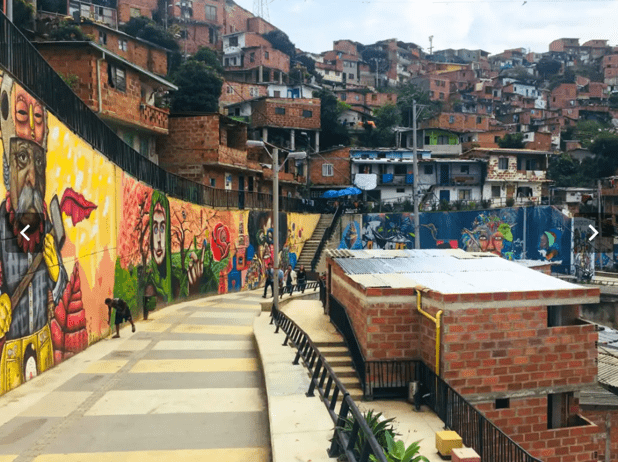
After three weeks in Colombia, the fourth stage of our Odyssey ended on Wednesday April 27, 2022.
¡Qué chimba! The meeting of 14 collaborators, 12 companies and many “Paisas” in Medellín and “Rolos” in Bogotá allowed us to understand the Colombian managerial and societal culture.
As for Norway, Iceland and Brazil, our understanding of the Colombian culture is obviously not comprehensive, and the examples we will give you do not reflect the behavior of all Colombian companies. However, the points we are highlighting in this article have come up regularly in our discussions.
Buena lectura ! (Have a good read).
During our visit to Rio de Janeiro, the topics of violence, poverty and inequality were very present. When we discussed with the locals the possible solutions to improve the situation, the example of the miracle transformation of Medellín appeared regularly.
But what transformation are we talking about? At this point, we have some preconceived notions about the city and we don’t know much of its history, except for the Escobar period.
In 1991, with 381 violent deaths per 100,000 inhabitants, Medellin had the highest homicide ratio in the world. Grey areas, without government control, are developing in the city. The situation seems to be completely out of control. Investments fall, confidence disappears, Colombia becomes, in the European and American minds, a dangerous country.
Yet, in 2013, it received the award for the “most innovative city in the world” by Urban Land. Five years later, the travel website TripAdvisor refers to Medellín as the “hottest destination in South America,” highlighting its safety and reputation.
We spent two weeks in Medellín, “City of the Eternal Spring”, and understood some of the components of this transformation. In this article, we will develop some of the most important points such as the access to transportation, education, positivity or even creativity, which explain, in our eyes, a part of Medellin’s miracle.
Throughout our meetings with companies, we realized that we were encountering elements that were common to those explaining the city’s transformation. We think that these elements are very inspiring for companies.
The people of Medellin have, for the most part, suffered from the city’s violent past. The weight of history is all the more important because this past is very recent.
However, we quickly feel a strong optimism and a great willingness in our interactions with the local people.
We can concretely perceive this optimism, during our visit of the San Antonio square with our touristic guide, Carolina, born in Medellín.
On this square we notice two bird sculptures, one of which is partially destructed. Faced with our curiosity, Carolina explains the place’s history.
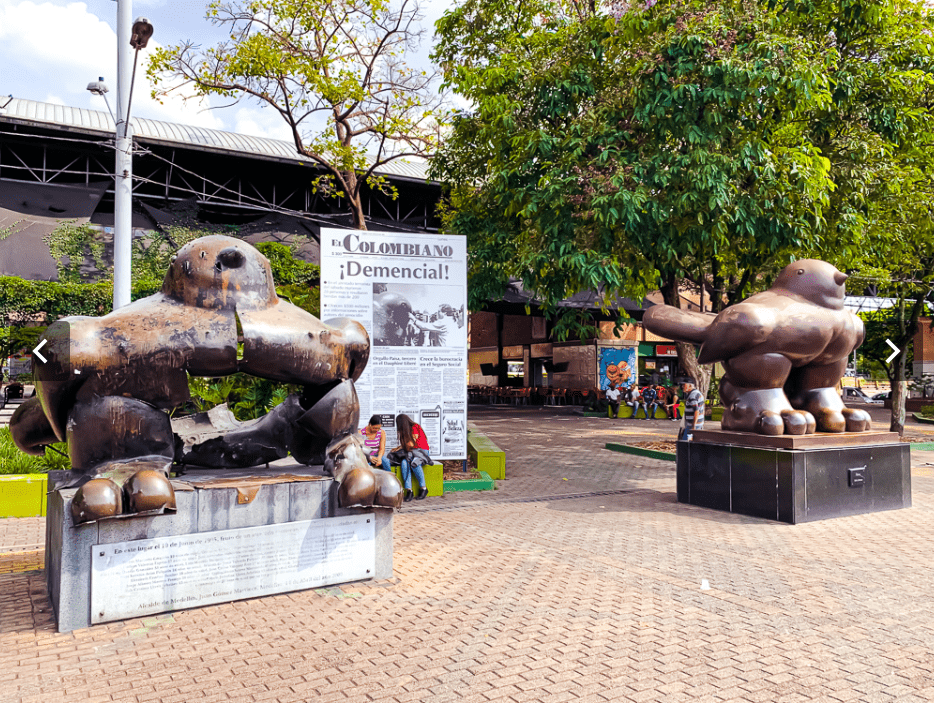
San Antonio Square was inaugurated in 1994 as a cultural center. In 1995, an individual placed a bomb in the sculpture of Fernando Botero, a famous Colombian artist. The bomb exploded at a concert and killed innocent people.
Faced with this tragedy, the city council of Medellín wanted to remove the sculpture of the bird. Fernando Botero called the mayor, proposing to leave the destroyed sculpture and to build a new one next to it.
The symbolism behind this act is strong and reflects the mentality of the residents, Carolina explains: the first bird, destroyed, symbolizes the tragic aspect of the city’s history, its difficulties, its violence. The second bird, identical to the first but rebuilt as new, is a symbol of peace, hope, and optimism.
The two birds are side by side to indicate that the suffering is present, that it must not be forgotten, but that the inhabitants will rebuild together, thanks to their resilience, a future full of hope and optimism.
We ecounter this vision during several business visits. María, director of the Club de Innovación Colombia, tells us about the great difficulties she had to face when launching this club focused on innovation (almost non-existent innovation ecosystem, corruption, the fact of starting up as a woman…). The same observation was made during our exchanges with Paola, committed to the transformation of the city at the RutaN innovation center or with Juliana, founder of CreativeLab.
However, each time, we perceive a great resilience, an ability to adapt to the unexpected, to the difficulty and especially a lot of optimism and perspective regarding difficult situations.
As if difficulty and optimism were two sides of the same coin. Obviously, these corporate behaviors seem to us to be inseparable from the history of the city and the daily lives of its inhabitants.
In order to cope with difficulty, we were also surprised by the creative capacity of companies and residents. Being able to do a lot with nothing, to innovate, and think differently.
We understand the extent of the creativity of the people of Medellín during our visit to Comuna 13.
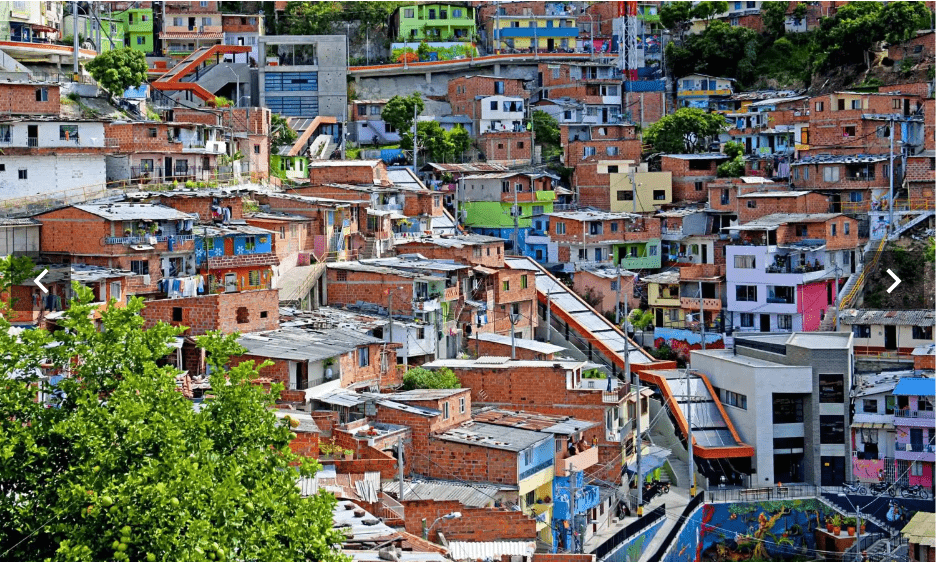
Comuna 13 is a neighborhood in Medellín that has long been considered a strategic area for drug trafficking. In the 1980s and 1990s, Comuna 13 was considered one of the most dangerous neighborhoods in the world. It was run by violent drug trafficking organizations, which used this poor, sprawling hillside barrio as a transit route in and out of the city, and served as a stronghold for guerrillas, gangs and paramilitaries.
We were talking about history and recent trauma: in 2002 President Alvaro Uribe launched Operation Orion, a raid on Comuna 13 led by 3,000 soldiers. In the first week of the raid, at least 18 people were killed, 34 injured and nearly 250 arrested. The 100,000 residents of the neighborhood were caught in the crossfire, resulting in arbitrary detentions, disappearances and hundreds of injuries.
Julio, our guide, a native of Comuna 13, explains that even today, some disappearances have never been solved and that many inhabitants of the neighborhood, including his family, have suffered and still suffer from this past.
Nevertheless, during our visit to the Comuna, we feel an incredible energy, a lot of positivity and joy in the middle of a very visible poverty. We are very surprised by the amount of frescoes, paintings, of creation and people dancing. All this creativity is, according to Julio, a way for the people of the neighborhood to express their anger and their hopes. He adds that this creativity has allowed the Comuna to become a major tourist spot in the city, to create new wealth and to start a virtuous circle again.

We recognize this powerful creativity in the companies we meet as well. Roger, CEO of the company CreativeLab, presents to us the practice of the “bebida”.
To onboard and integrate a new employee, the teams get together over a common drink. The new employee must then present themselves, and tell their story by using 5 emojis. He/she must not say anything about these 5 emojis and it is the other contributors who must try to guess the story that is being told.
Similarly, to introduce itself to new customers, the company sends a cardboard box filled with creative games. The goal is to introduce the CreativeLab mentality and to start the new collaboration positively.
Creativity is found in the Colombian companies we met and in the history of the city. However, the transformation of Comuna 13 and the city of Medellín can also be explained by other elements such as mobility, through easier access to transportation.
During our visit to Comuna 13, we understood the importance of accessibility in the development of a place. Indeed, the Comuna is built in heights, on hills. Julio, our guide, explains that getting to your home when you live in Comuna 13 is the equivalent of walking up 25 flights of stairs. Without transportation, the inhabitants did not necessarily have access to the rest of the city, and, in doing so, to more economically dynamic areas. A vicious circle was thus instilled.
Since the end of the 1990s and the start of the city’s transformation, public authorities have focused their development policies on the poorest neighborhoods in order to create an upheaval in these neighborhoods, as well as in living conditions and therefore in mentalities. This philosophy of “more beautiful for the poorest” led to the creation in 2004 of the first monocable gondola in Medellín. The city’s innovation lies in the use of these famous “Metrocables” as a means of mass urban transport for its inhabitants. There are now 6 lines, directly connected to the metro and tramway through multimodal stations. Metrocables connect isolated neighborhoods geographically and socially, and improve the quality of life of its residents by providing faster, safer and more reliable access to downtown jobs and services.
We had the chance to meet Renaud, CEO of the company Poma à Medellín. Poma is a French company specialized in the manufacture of cable transportation systems. The company was responsible for the construction of a large part of the “Metrocable” lines. Renaud tells us during our exchange the impact of these transports on the locals and their beneficial aspects.
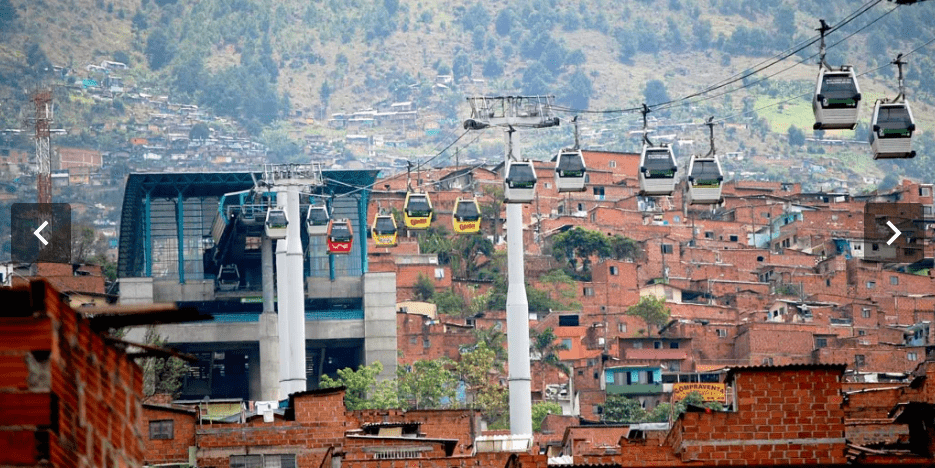
The Medellín subway is also a major innovation in the city. On November 30, 1995, at 11:00 a.m., the commercial operation of the Medellín subway was launched. The city was then divided between rich and poor districts. The construction of the metro is an example of continuity in public policies. During the construction, several mayors succeeded each other and yet, the construction of the subway continued. The “Paisas” are very proud of this metro, which is reflected in its impressive cleanliness.
In the city’s transformation, the educational project is integrated very early on to develop the inhabitants’ sense of social responsibility towards the city. For example, our guide Julio, asks us not to give money to children who approach us during our visit to Comuna 13. He explains to us that it is essential that these children go to school and that if they start to find sources of income they will not go anymore. Renaud from the company Poma said the same thing. He explained to us the difficulties in accepting these transport infrastructures in these areas and the need to explain the potential benefits to the inhabitants via educational moments on the subject. For this, Poma has invested time and money in educational projects on these issues.
Earlier in the article we talked about the uncertainty which reigned and still reigns today in the country. No wonder then that we met Camilo, director of the school Quántica Education in Colombia, the school that teaches how to deal with uncertainty and chaos.
It is based on a different model of education than the one we know: the Chaordic Model.
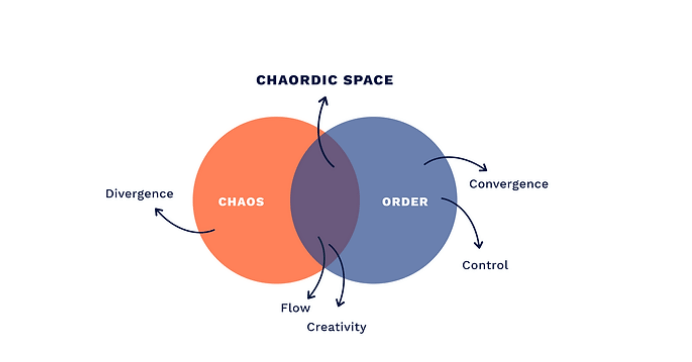
In this model, one must understand that:
– Chaos = Discomfort zone
– Order = Comfort zone
With the Chaordic Model, Quantica challenges students to create, design, and explore on their own, pushing them out of their comfort zone (divergence and chaos) while sharing theories, guides, and tools (convergence and order) to make sense of experiential learning to better internalize and apply it.
One of the exercises performed was on emotional independence.
Camilo says that humans expect a reaction from their audience when they announce good or bad news. Joy and recognition if it is good, or reassurance and comfort if it is bad. The exercise here is not to depend on these reactions and to be emotionally self-sufficient.
Camilo then asks one of the participants to announce some very bad news (“I lost my job yesterday”, “my dog died”) or on the contrary some great news (“my first child was born”, “I have just been hired by the company of my dreams”) in front of a large assembly which will have the mission to not have an ounce of reaction to the news.
According to Camilo and we agree with him: “At the end of the day, the first and most vital connection and relationship you have is with yourself”
We have presented here the miracle of Medellín’s transformation and the ties that can be made for good management practices. However, some limitations and difficulties persist and must not be forgotten.
– The feeling of insecurity still exists: one evening in our hostel, we meet Alejandro, a 22 year old Colombian. After several minutes of discussion and our admiration for the city of Medellín, Alejandro explains that he wants to finish his studies in Colombia and leave for Europe as soon as possible. In response to our questions, he explains that the feeling of insecurity is still very present in the country and particularly in Medellín. Obviously, not everything is perfect in the city of Medellín and the development issues are both still very real and of major importance.
– In companies, several professionals explain that the working days in Colombia are very long and often quite unproductive. Colombians regularly work weekends. The legal working hours are 48 hours. The logic of ‘command and control’ still exists in many companies.
We have presented here the miracle of Medellín’s transformation and the ties that can be made for good management practices. However, some limitations and difficulties persist and must not be forgotten.
– The feeling of insecurity still exists: one evening in our hostel, we meet Alejandro, a 22 year old Colombian. After several minutes of discussion and our admiration for the city of Medellín, Alejandro explains that he wants to finish his studies in Colombia and leave for Europe as soon as possible. In response to our questions, he explains that the feeling of insecurity is still very present in the country and particularly in Medellín. Obviously, not everything is perfect in the city of Medellín and the development issues are both still very real and of major importance.
– In companies, several professionals explain that the working days in Colombia are very long and often quite unproductive. Colombians regularly work weekends. The legal working hours are 48 hours. The logic of ‘command and control’ still exists in many companies.
When you write the word “Medellín” in the Google search bar, the first question that appears is the following:

We hope that this article will change your vision of the city of Medellín and the prejudices we have.
This city will remain a great favorite of our trip and our time here will have inspired us enormously for the rest of our adventure and our relationship with uncertainty and difficulties.
Source: https://odysseemanageriale.com/2022/05/31/etape-4-colombie-%f0%9f%87%a8%f0%9f%87%b4/
| Cookie | Duration | Description |
|---|---|---|
| cookielawinfo-checkbox-analytics | 11 months | This cookie is set by GDPR Cookie Consent plugin. The cookie is used to store the user consent for the cookies in the category "Analytics". |
| cookielawinfo-checkbox-functional | 11 months | The cookie is set by GDPR cookie consent to record the user consent for the cookies in the category "Functional". |
| cookielawinfo-checkbox-necessary | 11 months | This cookie is set by GDPR Cookie Consent plugin. The cookies is used to store the user consent for the cookies in the category "Necessary". |
| cookielawinfo-checkbox-others | 11 months | This cookie is set by GDPR Cookie Consent plugin. The cookie is used to store the user consent for the cookies in the category "Other. |
| cookielawinfo-checkbox-performance | 11 months | This cookie is set by GDPR Cookie Consent plugin. The cookie is used to store the user consent for the cookies in the category "Performance". |
| viewed_cookie_policy | 11 months | The cookie is set by the GDPR Cookie Consent plugin and is used to store whether or not user has consented to the use of cookies. It does not store any personal data. |